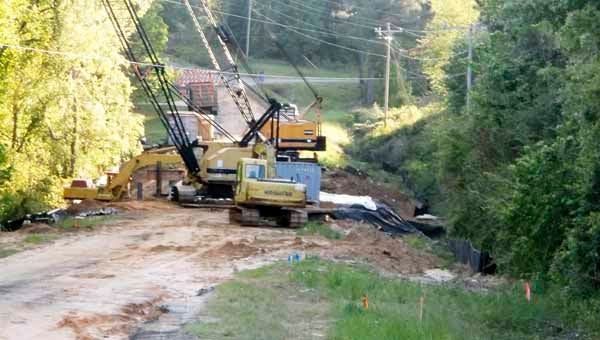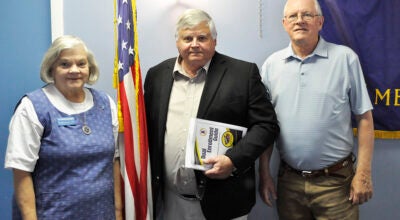County reports 57 roads on resurfacing priority list not covered by grants
Published 11:00 pm Friday, April 26, 2013

The Pike County Commission started the reconstruction process of County Road 2214 crossing over Indian Creek in February. The bridge prevented all traffic weighing more than six tons from passing through and caused school bus detours.
The process for roads and bridges to be considered for the Pike County Commission Resurfacing Priority List is intricate and lengthy.
Every year, all of the paved roads that are owned by the county are evaluated through annual maintenance inspections. That’s 730 miles of roadway and 168 bridges. Only 415 miles of those roads are paved.
Most of the inspections are done by the Alabama Department of Transportation, and the county engineer’s office personnel will do the rest of the inspections.
“There are many different elements that are evaluated,” said County Engineer Russell Oliver. “The roadways, shoulders, drainage and many others factors are considered.”
Oliver said that the overall score for the roads to be in excellent condition is 100. When making determinations for the resurfacing priority list, the focus is on the surface element score.
The surface element, which describes the condition of a road and its rating, has a total of 40 out of 100. Forty is to be considered a perfect rating.
The ratings include several sub-elements from failed conditions to excellent conditions. In between failed and excellent conditions on the scale there is a rating of poor conditions.
“Any paved road that has at least one surface element rated in poor condition, or has an overall surface element rating of less than a score of 33, is placed on the County Commission resurfacing priority list,” he said.
All of the roads and bridges currently on the priority list have a score of below 40 and are rated in poor conditions.
County Administrator Harry Sanders said there is much roadwork to do and rarely does the state give road money to counties.
The commission was able to secure $9 million through the Alabama Transportation and Rehabilitation Improvement Program, but ATRIP is funded through a federal aid program that has restrictions as what funds can be used for and the state is limited to using the funds for only major roads and bridges.
In Pike County, there are 17 major roads on the resurfacing priority list. Fifty-seven local roads and 15 minor roads also need work.
“This is a positive impact for Pike County that we received several million for resurfacing projects,” Sanders said of the ATRIP money. “Eighty percent of ATRIP projects are funded with the money we receive and the county provides a 20 percent match. That gives us a limited scope of roads to get done.”
In addition to the ATRIP program, the commission received a $350,000 Community Development Block Grant in September, but that can’t be used for local road projects. Oliver said that CDBG money is only for minor and major collectors that are on the priority list.
Larry Childers, director of communications and information for the Alabama Department of Economic and Community Affairs, said the state receives a CDGB allocation each year from the U.S. Department of Housing and Urban Development and that the Alabama Department of Economic and Community Affairs administers that money on behalf of the governor.
“The CDBG program was established by Congress to help low- and moderate- income residents, so the benefit to LMI persons is the most important criterion used to select which grant requests will be funded,” Childers said.
At least 51 percent of the beneficiaries of a proposed project must be LMI persons, and a greater LMI benefit enhances the likelihood that a request will be funded, he said.
Last year, Pike County submitted its application as part of a competitive process in which applicants were sorted into three groups, which are small cities, large cities and counties.
Twelve counties submitted applications, but funds were limited. This meant that only eight counties could be selected.
“The Pike County Commission applied for $350,000 [the ceiling in 2012] and received the full amount of its request, and the county agreed to spend $142,850 in local matching funds for the proposed road improvements,” Childers said.
Resurfacing and bridge repair work is already underway regarding the project at the top of the county’s priority list – a bridge north of Goshen where County Road 2214 crosses Indian Creek.
The road and bridge were in such disrepair that Oliver said any vehicle weighing more than six tons had to detour around the bridge. That meant even school buses were forced to take indirect routes between children’s homes and schools.
“Replacing the bridge will create more school bus traffic and savings with the school board,” Sanders said.
Current grants and matching funds should provide about $13 million in roadwork for the county’s major and minor collectors. However, local roadwork must come directly from county funds.
The county commission discussed adding a five-cent sales tax to gas sold in the county in order to generate more money for the 57 local roads, and future local roads, on the priority resurfacing list. However, the commission decided against the measure after receiving much pushback from county residents.
The county commission is now looking at other ways to reaching a long term solution to funding road repairs in Pike County.





